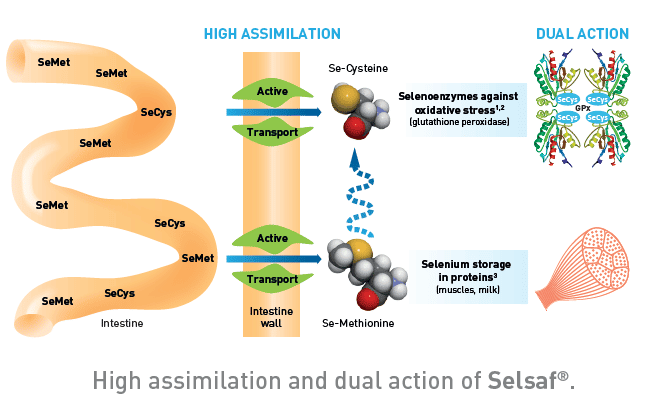19 Nov Sport horses: how the dual qualities of Selsaf® help maintain high levels of performance?
 High sport activities lead to muscle damages and delayed recovery
High sport activities lead to muscle damages and delayed recovery
A horse’s muscle structure consists of several types of fibres, all with different characteristics and functions. In sports or racehorses, II-A fibres, which require oxygen, are important for well-trained, athletic horses. II-X fibres, which are conversely anaerobic, are key for the production of short-duration, high-intensity bursts of power (Hinchcliff, Kaneps, & Geor, 2014).
II-A fibres take their energy mainly from the oxidation of glucose, which is present in the animal’s cells or produced from liver. This chemical reaction (part of cellular respiration), releases unstable oxygenated substances called «free radicals» or Reactive Oxygen Species (ROS). Once released, ROS attack cell membrane lipids, which they break down by oxidative process. This may result in significant damage to cell structures.
During periods of intense sporting effort, II-A fibres are highly stressed, causing their energy needs to soar. Cellular respiration also accelerates during this time, releasing large quantities of ROS which attack the animal’s muscle cells membranes, causing muscular damage. This process is known as oxidative stress.
Oxidative stress in horses, caused by exercise, may contribute not only to muscle damage, but also to fatigue, exercise intolerance, and reduced performance.
Selenoproteins, as antioxidant enzymes, help to lower the impact of oxidative stress
Selenoproteins are proteins in which at least one of the amino acid components contains selenium (Se). A lot of these proteins also have antioxidant properties. The best known selenoprotein is Glutathione peroxidase (GPx), a potent antioxidant which reduces the formation of hydroperoxide, one of the first free radicals to be released. GPx may also be considered as a cell-based storage reservoir of Se.
As a highly-efficient antioxidant enzyme, GPx is essential for the neutralisation of the reactive oxygen species which cause oxidative stress. Its activity is heavily dependent on the presence of Se in the body. In human athletes, oral Se supplementation significantly decreases lipid hydroperoxide levels, while increasing GPx in plasma, erythrocyte, and muscles. Although Se supplementation has no beneficial impact on aerobic or anaerobic athletic performance, it may prevent Se deficiencies among athletes which undertake high-intensity and high-volume training (Fernández-Lázaro, 2020).
In Europe, where soils suffer from selenium poverty, Se intake is often insufficient. In a study carried out in endurance competition horses, about one third were found to be deficient in selenium. This finding was subsequently associated with an increased risk of counter-performance in affected horses (Demangeon, 2007).
Maintaining optimal Se plasma levels may be important in relation to minimising chronic exercise-induced oxidative effects and modulating the impact of exercise on mitochondrial changes (Fernández-Lázaro, 2020). The daily requirement for Se in 500 kg horses is currently defined as 1 mg. This requirement increases to 1.13 mg per day and 1.25 mg per day in horses which undertake moderate to heavy exercise, respectively (National Research Council-NRC, 2007).
Using Selsaf® – a highly bioavailable source of two synergic seleno-organic compounds – to increase protection against oxidative stress.
Selsaf® is an approved additive for use with all animal species (FEEDAP, 2020). Produced from the cultivation of a proprietary Saccharomyces cerevisiae (CNCM I-3399) strain, on a Selenium enriched substrate, Selsaf® contains both Selenocysteine and Selenomethionine, two major biologically active seleno-organic compounds. Thanks to a reliable and standardised production process, the obtained concentration in organic Se is high in Selsaf®, while the profile active seleno-compounds is
stable and consistent.
Once ingested, Selsaf® compounds are absorbed into the small intestine active transport systems. Their absorption is much more efficient than that of sodium selenite, which is passively absorbed. Due to its composition, Selsaf® can be compared to a two-stage rocket:
- For immediate action, Selenocysteine offers natural protection against oxidative stress via selenoenzymes,
such as glutathione peroxidase (GPx) - For longer-term action, Seleno-Methionine (63% at least of organic form present in Selsaf®) is incorporated and stored in the muscles, where it can be mobilised in times of stress. When antioxidant defences need to be improved, Seleno-Methionine is released from this muscle reserve and used for the production of the animal’s seleno-enzymes (Schrauzer, 2000).
Different studies, designed to measure GPx activity in various animal species, indicate that Selsaf® is efficiently used in the construction of functional GPx. Due to Selsaf®’s seleno-organic compounds, GPx activity reaches a higher level than that obtained from supplementation with mineral forms such as selenite.
Conclusion
In summary, the dual effect of Selsaf® enhances selenoprotein GPx activity and increases antioxidant defence in sports horse, reducing oxidative damage. As a result, top level performance can be maintained!
Bibliography
Demangeon. (2007). Iode, sélénium et antioxydants chez le cheval d’endurance : évaluation du statut sanguin et des facteurs de variation chez 54 chevaux de haut niveau. Thèse ENVA.
FEEDAP. (2020). Assessment of the application for renewal of authorisation of seleniumenriched yeast produced by Saccharomyces cerevisiae CNCM I‐3399 for all animal species.
EFSA Journal 2020, 18(5):6144 (https://doi.org/10.2903/j.efsa.2020.6144). Fernández-Lázaro, D. (2020). The Role of Selenium Mineral Trace Element in Exercise: Antioxidant Defense System, Muscle Performance, Hormone Response, and Athletic Performance. A Systematic Review. Nutrients, 12(1790).
Hinchcliff, K., Kaneps, A., & Geor, R. (2014). Equine Sports Medicine & Surgery – Basic and Clinical Sciences of the Equine Athlete (2nd Edition). Saunders Elsevier.
National Research Council-NRC. (2007). Nutrient Requirements of Horses: Sixth Revised Edition. (T. N. Press, Éd.) Washington, DC: The National Academies Press.
Schrauzer, G. (2000). Selenomethionine: A Review of Its Nutritional Significance, Metabolism and Toxicity. The Journal of Nutrition, 130(7), 1653–1656.










Sorry, the comment form is closed at this time.